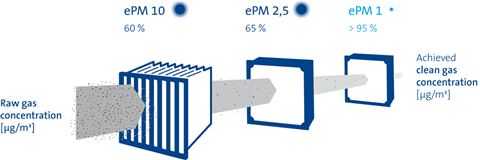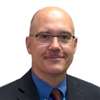Freudenberg’s simulation software helps operators optimize air filtration
14 October 2021
Uses site specific data
Dust and moisture in the intake air of gas turbines cause deposits on the blade surfaces known as ‘fouling’, as well as corrosion damage in the hot gas area.
This results in higher heat rate and less efficiency while maintenance effort and costs also increase. Multi-stage air intake filter systems provide protection and functional reliability – as long as they are precisely tailored to the requirements of the plant and the specific environmental conditions at the power plant location.
The relationship between the dust mass entering the compressor of a gas turbine over a period of time and the loss of turbine performance it causes can serve as an important parameter in selecting the most economical sequence of filter classes in multi-stage systems. Because air filters always separate a percentage of particles, site-specific dust concentrations affect the dust load entering the compressor. A high concentration of dust at a specific site means that a correspondingly higher dust load will be transported into the turbine.

But how can operators find site-specific data and how can that be incorporated into the filtration selection process? Freudenberg Filtration Technologies believes it has an answer with its simulation software, the electronic Freudenberg Filter Efficiency Tool, or e.FFECT for short. With e.FFECT, Freudenberg Filtration Technologies said it is able to configure individually optimized air filter systems tailored to the specific needs of turbomachinery operators.
Factoring total cost of ownership
“The power output is influenced by the dust ingress into the machine and the dust is building up deposits on the blades,” said Thomas Schroth, Market Segment Manager Turbomachinery for Freudenberg. “But the power output is also influenced by the pressure drop—the airflow resistance of the filters—and basically the software is providing a total cost of ownership calculation based on site-specific conditions where the power plant is located.”
e.FFECT maps the actual operation of a plant onto a digital model. Based on the site-specific conditions and relevant variables for efficient operation, the software tool compares the filtration systems in question and determines the best solution. This is necessary because the more specifically a filter system is tailored to the respective plant requirements, the more efficiently, safely and economically it can be operated, according to Freudenberg. In the case of turbomachinery, this typically involves the use of multistage filter systems: coordinated, sequentially connected combinations of pocket, cassette and/or cartridge filters. e.FFECT calculates the individual filtration efficiency of each filter stage and the accumulated quantities of dust per filter element.
One factor that influences the filtration system is the composition of the local ambient air. To ensure that the intake air filter system can be precisely designed, it is therefore important to know where a power plant is being operated. This may be in an urban area with high levels of submicron particulate matter, in a rural region with a high pollen count, near a humid coastline, or in an area characterized by drought and high concentrations of coarse dust like for example sand. To analyze the supply air at a specific location, e.FFECT either uses the ongoing measurements of national environmental authorities or other available data of particle concentrations that can be determined in the immediate vicinity of the site.
e.FFECT makes potentials of performance gains visible
Process requirements and plant specifics, such as the intake mass flow of the turbomachine, are particularly important in determining the requirement profile for the filtration of the intake air. In the case of gas turbines, the main factors causing performance losses are fouling and the pressure drop of the particle-laden filters. e.FFECT uses the interaction of these calculation parameters to determine the optimum value for which the sum of the two system-inherent performance losses is the lowest.
Two extreme scenarios illustrate this point more clearly. An ultra-fine filter system with an extremely high degree of separation would hugely reduce fouling, but would lead to high reductions in performance due to pressure drops in the filter system. Conversely, using no filter system at all would mean zero pressure loss, but would severely accelerate and intensify fouling, resulting in a steep drop in power output and the efficiency of the system. By comparing different solutions, e.FFECT calculates the “golden mean”, i.e. the lowest average value that promises the highest power output.
“With the help of e.FFECT, our customers can be sure of implementing a site- and plant-optimized air filtration solution,“ Schroth said. “Our simulation and calculation tool incorporates the knowledge gained from decades of filtration experience, data evaluation from more than 50 actual power plants, and numerous tests at Freudenberg Filtration Technologies. Power plant operators can immediately see the savings potential and the resulting monetary effect and are thus in a position to make meaningful comparisons. The advantages are obvious: a tailor-made filtration solution leads to lower maintenance requirements, longer service life and reduced operating costs. It combines increased functional reliability and plant availability with improved cost-effectiveness.”
Schroth said e.FFECT serves as a proactive maintenance tool because it can predict lifetime of the filter based on site conditions.
“The lifetime of the filter depends on the dust at the site, so you can select certain filters and if I choose filter A it’s lifespan could be 12 months, but if I choose filter B with different features, it could be 18 months,” Schroth said.
Schroth said that some customers are using the e.EFFECT system in the planning stages for new power plants as well.
“We get requests from utilities when they plan a new power plant and when they speak to the OEM of the turbine they can request certain filtration systems in advance, ”he said. “They can tell the OEM‚ ‘We would like to have for this site filtration system A and B and in this sequence because this will be optimum for our operation.’”
Turbine OEMs naturally try to standardize their systems, so the end user has to be proactive in selection on the filtration system, Schroth said.
“You can get filters in different particle removal efficiencies, pressure drops and achievable lifetimes, so you can try to get the optimum filter for your site,” he said. “We cannot say one filter fits all—when I operate a turbine in an area with a low concentration of very small particles it might not be necessary to install a very highly efficient filter that removes those small particles but also produces pressure drop and power loss due to that pressure drop. It’s more about picking a tailor-made filtration system for the site.”
POWER SOURCING GUIDE
The trusted reference and buyer’s guide for 83 years
The original “desktop search engine,” guiding nearly 10,000 users in more than 90 countries it is the primary reference for specifications and details on all the components that go into engine systems.
Visit Now
STAY CONNECTED




Receive the information you need when you need it through our world-leading magazines, newsletters and daily briefings.
CONNECT WITH THE TEAM









